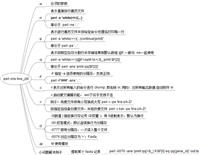可以通过参数控制生成密码中包括的字符种类
#!/usr/bin/perl
use strict;
use warnings;
use getopt::std;
sub show_help {
print "useage:\n";
print "newp -aansl\n";
print "-a\t\t the password contains lower case letters(a-z)\n";
print "-a\t\t the password contains upper case letters(a-z)\n";
print "-n\t\t the password contains numerical character(0-9)\n";
print "-s\t\t the password contains special symbols\n";
print "-u\t\t the password contains only unique characters\n";
print "-l length\t set the password length(default: 6)\n";
exit 0;
}
sub show_version {
print "version: 0.2.1 changed the default option: -l 9 -ana. 2016-4-15\n";
exit 0;
}
### main program
use vars qw($opt_a $opt_a $opt_h $opt_l $opt_n $opt_s $opt_u $opt_v);
getopts('aahl:nsuv');
&show_version if $opt_v;
&show_help if $opt_h;
my $len = $opt_l || 9; # default length 9
my $opt_cnt = 0;
my @rand_str = ();
# store all the characters
my @num = qw(0 1 2 3 4 5 6 7 8 9);
my @abc = qw(a b c d e f g h i j k l m n o p q r s t u v w x y z);
my @abc = qw(a b c d e f g h i j k l m n o p q r s t u v w x y z);
# my @sym = qw(! " $ % & ' * + - . / : ; < = > ? @ [ \ ] ^ _ ` { | } ~);
my @sym = qw(! $ % & * + - . / : ; < = > ? @ [ ] ^ _ ` { | } ~); # no " ' \
unshift (@sym, '(', ')', '#', ','); # to prevent perl's complains or warnings.
my @all_sym = (@num, @abc, @abc, @sym);
my @ch_src = ();
if ((!$opt_a) && (!$opt_a) && (!$opt_n) && (!$opt_s)) {
$opt_a++;
$opt_a++;
$opt_n++;
}
if ($opt_a) {
$opt_cnt++;
my $i = rand @abc;
unshift @rand_str, $abc[$i];
if ($opt_u) {
if ($i>=1) {
$abc[$i-1] = shift @abc;
} else {
shift @abc;
}
}
unshift (@ch_src, @abc);
}
if ($opt_a) {
$opt_cnt++;
my $i = rand @abc;
unshift @rand_str, $abc[$i];
if ($opt_u) {
if ($i>=1) {
$abc[$i-1] = shift @abc;
} else {
shift @abc;
}
}
unshift (@ch_src, @abc);
}
if ($opt_n) {
$opt_cnt++;
my $i = rand @num;
unshift @rand_str, $num[$i];
if ($opt_u) {
if ($i>=1) {
$num[$i-1] = shift @num;
} else {
shift @num;
}
}
unshift (@ch_src, @num);
}
if ($opt_s) {
$opt_cnt++;
my $i = rand @sym;
unshift @rand_str, $sym[$i];
if ($opt_u) {
if ($i>=1) {
$sym[$i-1] = shift @sym;
} else {
shift @sym;
}
}
unshift (@ch_src, @sym);
}
if ($len < $opt_cnt) {
print "the count of characters[$len] should not be smaller " .
"than count of character types[$opt_cnt].\n";
exit -1;
}
if ($opt_u && $len > (@ch_src + @rand_str)) {
print "the total number of characters[".(@ch_src + @rand_str).
"] which could be contained " .
"in password is smaller than the length[$len] of it.\n";
exit -1;
}
foreach (1..$len-$opt_cnt) {
my $i = rand @ch_src;
unshift @rand_str, $ch_src[$i];
if ($opt_u) {
if ($i>=1) {
$ch_src[$i-1] = shift @ch_src;
} else {
shift @ch_src;
}
}
}
foreach (1..$len) {
my $i = rand @rand_str;
print $rand_str[$i];
if ($i>=1) {
$rand_str[$i-1] = shift @rand_str;
} else {
shift @rand_str;
}
}
print "\n";
exit 0;
以上就是本文给大家分享的全部代码了,希望对大家学习perl能够有所帮助







发表评论